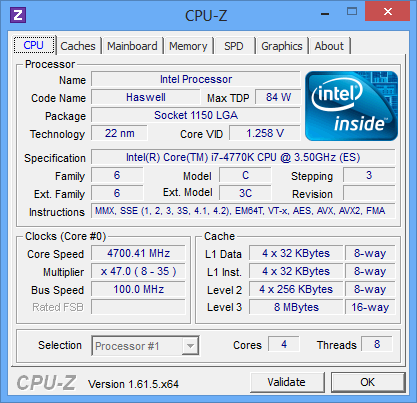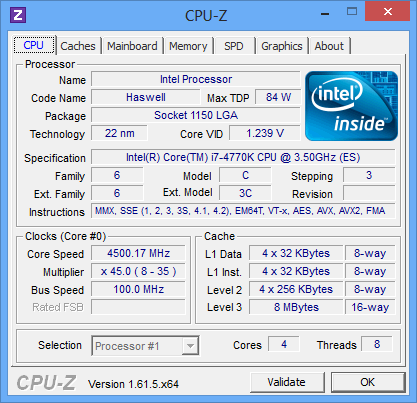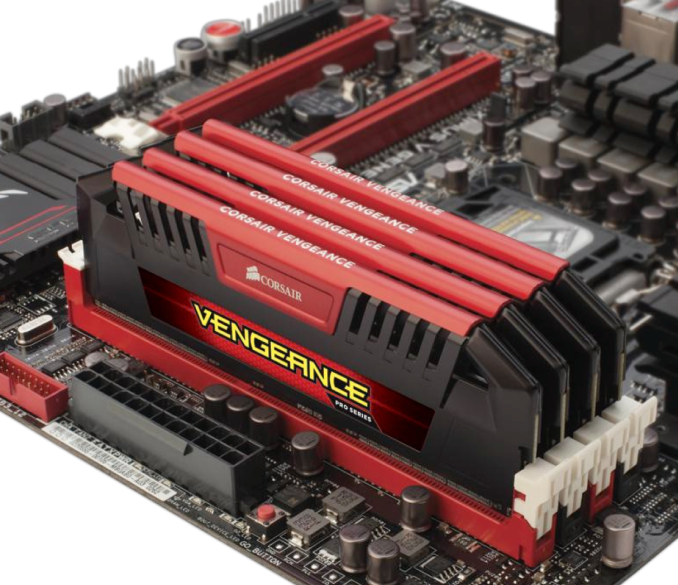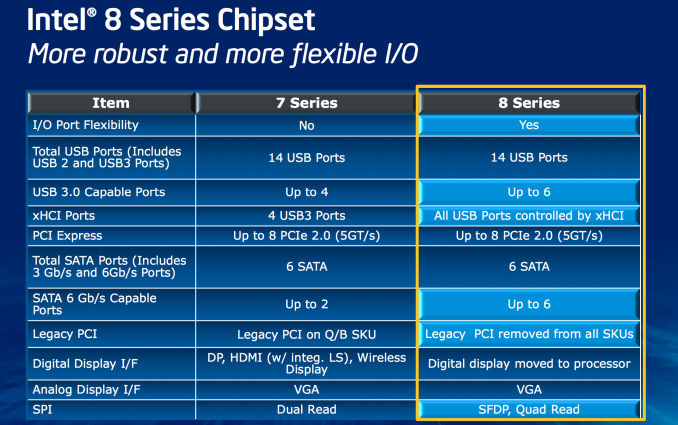The Haswell Review: Intel Core i7-4770K & i5-4670K Tested
by Anand Lal Shimpi on June 1, 2013 10:00 AM ESTMemory
Haswell got an updated memory controller that’s supposed to do a great job of running at very high frequencies. Corsair was kind enough to send over some of its Vengeance Pro memory with factory DDR3-2400 XMP profiles. I have to say, the experience was quite possibly the simplest memory overclocking I’ve ever encountered. Ivy Bridge was pretty decent at higher speeds, but Haswell is a different beast entirely.
Although I used DDR3-2400 for most of my testing, Corsair’s Vengeance Pro line is available in frequencies rated all the way up to 2933MHz.
Platform
Haswell features a new socket (LGA-1150). Fundamental changes to power delivery made it impossible to maintain backwards compatibility with existing LGA-1155 sockets. Alongside the new socket comes Intel’s new 8-series chipsets.
At a high level the 8-series chipsets bring support for up to six SATA 6Gbps and USB 3.0. It’s taken Intel far too long to move beyond two 6Gbps SATA ports, so this is a welcome change. With 8-series Intel also finally got rid of legacy PCI support.
Overclocking
Despite most of the voltage regulation being moved on-package, motherboards still expose all of the same voltage controls that you’re used to from previous platforms. Haswell’s FIVR does increase the thermal footprint of the chip itself, which is why TDPs went up from 77W to 84W at the high-end for LGA-1150 SKUs. Combine higher temperatures under the heatspreader with a more mobile focused chip design, and overclocking is going to depend on yield and luck of the draw more than it has in the past.
Haswell doesn’t change the overclocking limits put in place with Sandy Bridge. All CPUs are frequency locked, however K-series parts ship fully unlocked. A new addition is the ability to adjust BCLK to one of three pre-defined straps (100/125/167MHz). The BCLK adjustment gives you a little more flexibility when overclocking, but you still need a K-SKU to take advantage of the options.


In terms of overclocking success on standard air cooling you should expect anywhere from 4.3GHz - 4.7GHz at somewhere in the 1.2 - 1.35V range. At the higher end of that spectrum you need to be sure to invest in a good cooler as you’re more likely to bump into thermal limits if you’re running on stable settings.

















210 Comments
View All Comments
random2 - Monday, June 3, 2013 - link
Other reviewers are getting the more standard 10-15% difference on average across the board typically seen with Intel and a new gen. introduction over their previous gen. If it's not being seen here, maybe there are benches not included that should be.Achaios - Tuesday, June 4, 2013 - link
1.72 FPS difference between an i7-2600k and an i7-4770k. This is so hopelessly pathetic.My QX9650 and my Asus P5Q Deluxe just got a 2 year life extension. I wonder when it's going to be worth it to finally ditch my 2008 system!!!
Arbie - Wednesday, June 12, 2013 - link
The CPU does not control the FPS you're talking about. Beyond a certain point of CPU power (long ago passed) FPS depends on the external graphics card. A Haswell i7-4770K CPU will, according to the Anandtech benchmarks, be about twice as powerful as your QX9650. At 1/3 the cost, and far less idle power. That's not "pathetic".You may very well not want to upgrade, because you won't see a difference in your games - but that isn't Intel's fault. In fact it's a problem for them and the desktop market in general. Gains in CPU power are becoming irrelevant. As are PC games, BTW, which is why graphics cards are improving so slowly now. In two more years... it will be the same story, except more so.
monohouse - Sunday, June 23, 2013 - link
+1, I upgraded my system:from a E6750 (3800 Mhz, 4MB) to E8400 (4300 Mhz, 6MB)
from GTX 480 (840 Mhz, 1.5 GB) to GTX 580 (930 Mhz, 3 GB)
and got the same FPS in crysis 2 (with MaLDo HD + hi-res textures + DX11)
shows that in some cases, there is no improvement
Gastoncapo - Wednesday, June 5, 2013 - link
honestly, i'm still running my 2500k @5ghz ...i don't see the point in upgrading yet, guess i'll just switch my 580 gtx for a 780 :DNillerboy - Sunday, June 9, 2013 - link
will there be made a review of Intel 4770S?I am considering making a lab with this cpu, and would like to see proformence difference between the Intel 4770 and 4770S.
C433 - Wednesday, June 12, 2013 - link
second this, best would be to also include 4670S and at least one of the T modelsThomasS31 - Monday, June 10, 2013 - link
Anand,What is intels response to the overheating/throttling issues with stock cooler haswell (not OC).
Can you investigate this issue more (as you can as ususal).
Seems there are some manufacturing quality issues with the heat spreader and thermal paste.
Arbie - Wednesday, June 12, 2013 - link
Just some info for others considering a Haswell desktop build.I have just assembled an i5-4670K on an Asus Gryphon Z87 mATX mobo, with 8GB of Corsair Vengenace RAM (1333MHz) and a GTX 650ti graphics board. This is with a 250GB Samsung SSD and a old 500GB mechanical drive. The PSU is a Corsair CX600 80-Plus.
==> At stock clocks, idling on the Windows desktop, this PC pulls only 39W from the wall!
I am amazed. Idle power is important to me since the box is in a poorly-ventilated room. Upping the AC to improve that area would freeze the rest of the house AND cost a bundle. The time periods spent at full load are negligible in comparison. But the performance is there when needed... this CPU is nearly twice as powerful as my Yorkfield build, which idles at 170W, with HD 5770 gfx and an SSD.
So I'm very pleased with Haswell on the desktop. And yes, I could have bought a lower level chip and mobo for this use, saving money and a few more Watts, but I wanted the good stuff and the PC may someday be moved to where an OC would be practical.
emperius - Friday, June 14, 2013 - link
Well I certainly can wait for AMD to truly boost their competition from Sony and Microsoft's budget here. Let's face it, multi-year contract for console apu's should economically boost them massively.